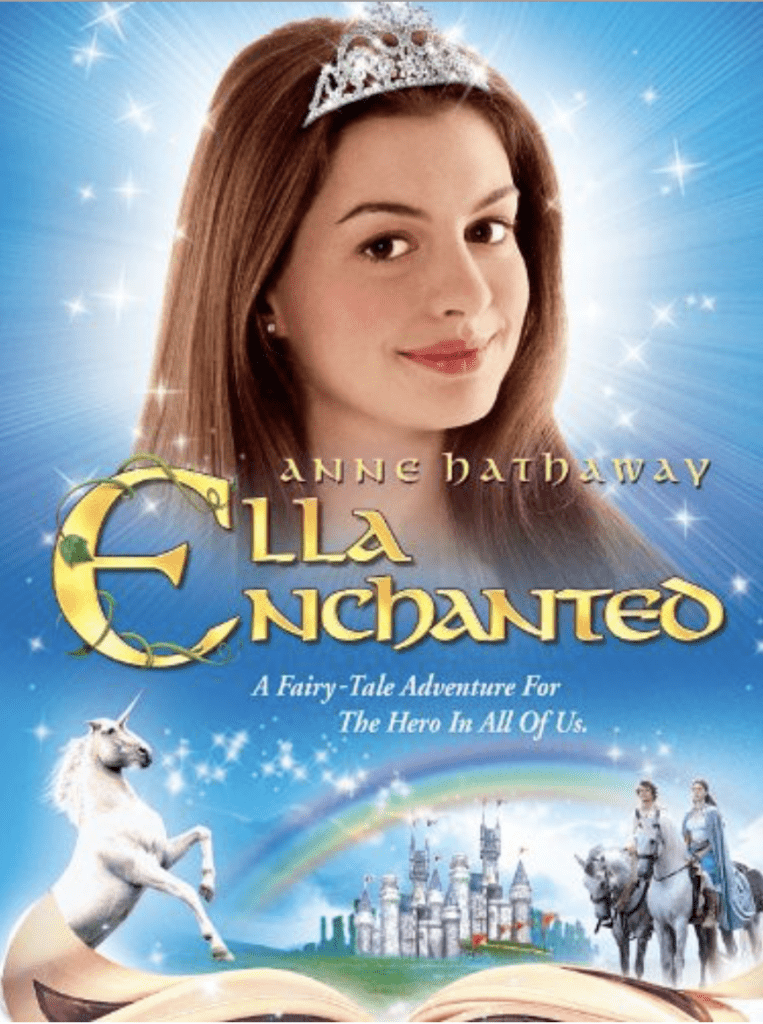Ella Enchanted (dir. Tommy O’Haver) is one of my favourite childhood films; part of an eclectic list of classics including Charlie and the Chocolate Factory (the one with Johnny Depp), Labyrinth and Disney’s Lilo & Stitch. The fantasy romcom is a revisionist epic for young girls, which extols the importance of compassion, courage and intelligence, set to a rollicking Disney-orientated soundtrack featuring Kelly Clarkson, Raven-Symoné Pearman (from That’s So Raven) and Anne Hathaway herself. To me, it is much more than a ‘hip, accessible medieval road trip’ from 2004.
The film follows the journey of Ella of Frell, who receives the gift of obedience as a baby from her dodgy fairy godmother. As she reaches adulthood, Ella decides to rid herself of the gift, to free herself from being at the mercy of her cruel ugly stepsisters Hattie and Olive. This leads her through an enchanted landscape populated by giants, ogres, elves, and fairies, all oppressed by the odious Sir Edgar and his talking snake, Heston. Ella also meets the dashing Prince Char (short for Char…mont), and they slowly fall in love during Ella’s crusade for personal and kingdom-wide liberation.
I was able to relate to Ella on a deep level because we both have brown hair. It was my Princess Bride. They even cast Cary Elwes (Westley in T.P.B) as Sir Edgar. Another less fortunate similarity between the two films is the presence of a thin, bafflingly unattractive moustache upon the male lead’s upper lip. But what family-friendly flick today would include lines such as ‘Sir Edgar has done a fantastic job…if it weren’t for him, we wouldn’t have today’s thriving free-enterprise system’, or ‘Say no to ogrecide!’ ‘Stop the giant land grab!’ Rewatching it years later, I began to wonder if my adoration of this film as a child is why I have come to view legislative justice as romantic.
There is an oversimplified distinction between Ella and her equally virtuous friend Areida (onscreen for less than five minutes) compared to the rest of the girls. While Ella and Areida are outspoken, empathetic and brunette, Hattie and Olive are entitled, malicious and blonde. The other girls in the film are the mindlessly hysterical and possessive Prince Char fanclub. In hindsight, this critique of celebrity culture and fandom is a bit sad, as it only gets worse from 2004.
The style of Ella Enchanted is exciting all by itself. Somebody must have felt the exaggerated flamboyance of medieval fashion, architecture and interior design deserved an early 2000s makeover. Woeful attempts to modernise medieval garb for the cool kids of 2004 are joyously kitsch nowadays. This is especially true for Hattie and Olive, resplendent in orange faux fur and lilac crushed velvet. The audacious ugliness of much of the costuming kept me going through the physical comedy and “witty banter” between Ella and Char. I also really appreciated other inventive touches bringing the fairy tale up to date, like the medieval shopping mall with a wooden escalator.
The film has multiple political messages, executed about as well as you would expect a 2004 fantasy rom com for kids to (read: not very well). In its own way, Ella Enchanted critiques fascist capitalism, celebrity culture, gender roles and racism. Ella’s ‘gift’ of obedience is more of a curse, promoting a feminist message regarding the archaic and damaging notion of obedience as a feminine virtue. She is also able to understand that ‘nobody should be forced to do something they don’t want to’ through her curse. It is her individuality, intelligence, courage and compassion that makes her attractive to the handsome, politically inept Prince.
Ultimately, Ella Enchanted is an endearing, quirky and enjoyable film which I would definitely recommend to today’s ten year olds.
– Frances Belt
Junior Girl
Girl Museum Inc.

